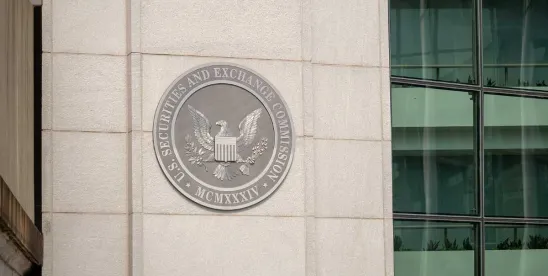Since the beginning of the year, the US Securities and Exchange Commission’s (SEC) Division of Corporation Finance staff (Corp Fin Staff) has issued several important statements and interpretations, including a Staff Legal Bulletin on shareholder proposals and multiple new and revised Compliance and Disclosure Interpretations (C&DIs). Given the pace and importance of these recent changes, it is critical that public companies be aware of the significant policy shift at the Division of Corporation Finance and the substance of the updated statements and interpretations.
This is the second part of an ongoing series that will discuss recent guidance and announcements from the Corp Fin Staff. This installment will review the new and revised C&DIs released by the Corp Fin Staff relating to unregistered offerings.
Securities Act Rules
On 12 March 2025, the Corp Fin Staff released a number of new and revised C&DIs relating to Regulation A and Regulation D under the Securities Act and withdrew many C&DIs that were no longer applicable.
Regulation A – Nonpublic Correspondence and State Securities Laws
Regulation A is a framework that is used primarily by smaller companies to raise capital in unregistered offerings. Regulation A has two offering tiers (Tier 1 and Tier 2) that have different eligibility requirements, offering limits, and disclosure obligations.
With respect to C&DIs regarding Regulation A, and specifically Securities Act Rules 251 to 263, the Corp Fin Staff revised three C&DIs to clarify certain filing requirements, requesting confidential treatment during a review, and certain registration requirements. The Corp Fin Staff revised Question 182.01 to specify how issuers can make previously submitted nonpublic draft offering statements publicly available at the time of the first public filing of the offering statement. It also clarifies that Corp Fin Staff will make nonpublic correspondence publicly available at the end of their review of the offering statement.
Revised Question 182.02 provides that during the review of a nonpublic draft offering statement, an issuer can request confidential treatment for correspondence by utilizing Rule 83 in the same way it would during a typical registered offering review. Additionally, Question 182.10 now clarifies that even though securities initially sold in a Tier 2 offering are exempt from registration, registration and qualification requirements under state securities laws are not preempted with respect to resales of the securities purchased in that Tier 2 offering unless separately preempted.
Regulation D – Foreign Issuers, Demo Days, and Accredited Investors
Regulation D provides an exemption from the registration requirements under the Securities Act for limited unregistered offerings and sales of securities. With respect to Regulation D, the SEC revised or issued new C&DIs regarding disclosure requirements for foreign private and Canadian issuers, the interplay between Regulation D and Regulation S for foreign offerings, when “demo days” or similar events would constitute a general solicitation, and verification of accredited investor status.
A demo day is an event in which startup companies can show their product or services to prospective investors. With respect to investor accreditation, issuers are limited in the number of nonaccredited investors they can offer and sell securities to in certain Regulation D offerings, and they have greater disclosure obligations to those nonaccredited investors.
Foreign Issuers
In revised Question 254.02, the Corp Fin Staff removed the reference to disclosure requirements for foreign private issuers being set forth in Securities Act Rule 502(b)(2)(i)(C) when using Regulation D, and this C&DI now just states “yes” to the question of whether foreign issuers can use Regulation D.
Question 255.33 provides that under Securities Act Rule 500(g), as long as a foreign offering meets the safe harbor conditions set forth in Regulations S relating to offerings made outside the United States, then the offering does not need to comply with the conditions of Regulation D (which in part limit the number of nonaccredited investors that can be included). The Corp Fin Staff revised this question to specify that the 35-person limit for the number of nonaccredited investors under Regulation D applies only within any 90-calendar-day period.
The Corp Fin Staff revised Question 256.15 to clarify that under Securities Act Rules 502(b)(2)(i)(B)(1) and (2), a Canadian issuer can satisfy the information requirements of Securities Act 502(b) using financial statements contained in a multijurisdictional disclosure system (MJDS) filing. The revision captures all financial statements rather than just the issuer’s most recent Form 20-F or Form F-1 and requires preparing the MJDS filing in accordance with International Financial Reporting Standards.
Demo Days
Question 256.27 now adds that in relation to “demo days” or other similar events, communications meeting the requirements of Securities Act Rule 148 will not constitute general solicitation or general advertising, even if the issuer does not have a pre-existing, substantive relationship with the persons in attendance. Revised Question 256.33 similarly highlights that if a demo day meeting the Rule 148 requirements is not a general solicitation, then it will also not be subject to limitations on the manner of offering by Securities Act Rule 502(c) (which sets forth limits on issuers from offering and selling securities through general solicitation or general advertising). Events that do not comply with Rule 148 will continue to be evaluated based on facts and circumstances to determine if they constitute a general solicitation or general advertisement.
Accredited Investors
Newly issued Question 256.35 establishes that, aside from the verification safe harbors in Securities Act Rule 506(c)(2)(ii), taking “reasonable steps to verify accredited investor status” first involves the issuer conducting an objective consideration of facts and circumstances of each investor and the transaction. Factors that should be considered under this analysis include the nature of the purchaser and what type of accredited investor they claim to be, the type and amount of information that the issuer has about the purchaser, and the nature of the offering. These factors should be considered interconnectedly to assess the reasonable likelihood that a purchaser is an accredited investor, which then helps the issuer determine the reasonable steps needed to verify that status.
New Question 256.36, in conjunction with Question 256.35, indicates that based on the particular facts and circumstances, a high minimum investment amount for an offering may serve to allow an issuer to reasonably conclude that it took reasonable steps to verify accredited status. This aligns with Securities Act Release No. 9415 (10 July 2013) and the recent Latham & Watkins no-action letter (12 March 2025) issued by the Corp Fin Staff that provides more detail about what conditions, along with a minimum investment amount, would evidence reasonable steps that a purchaser is accredited.
Conclusion
Many of the new and revised C&DIs discussed above are welcome changes and provide greater clarity with respect to unregistered offerings and sales of securities. These C&DIs are just a handful of the new and updated guidance issued by the Corp Fin Staff since the beginning of the year and reflect a policy shift by the SEC overall that will likely be continued in the months ahead.





 />i
/>i

